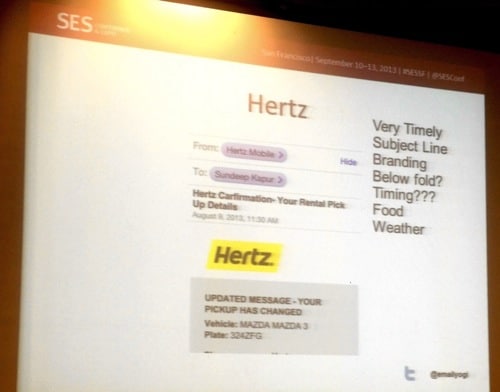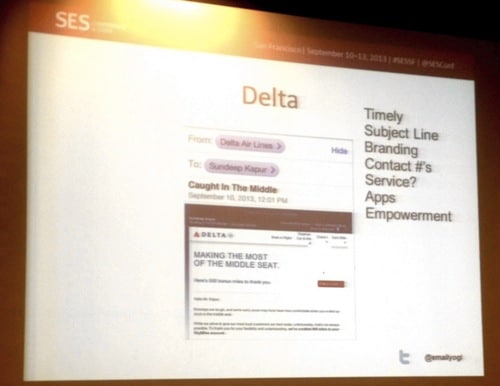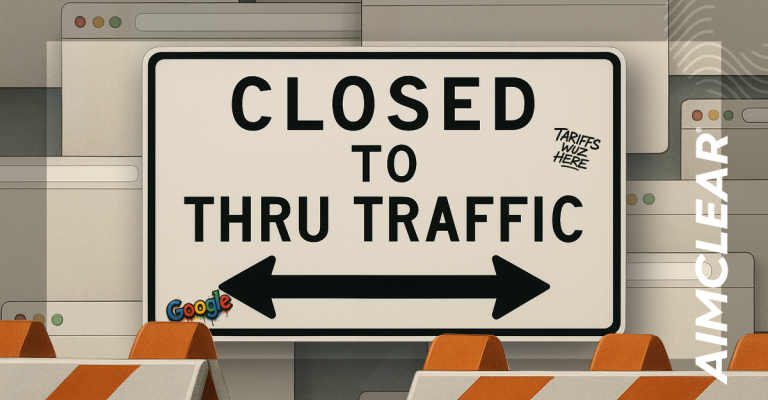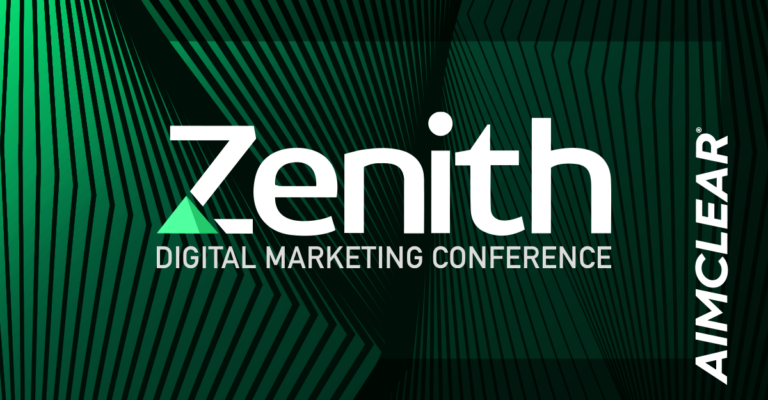Welcome back to AIMCLEAR blog for our final piece of coverage from SES San Francisco 2013! It’s been quite a ride this year, and we’ve just got one question left: How do you ensure delivery, drive double-digit conversion, and engage your consumer across multiple channels? Those desperate for answers congregated to Deliver, Engage, Transact: 11 Absolutes for Email Engagement, and geared up for some thought-provoking solutions to all things email. Read on to learn how email can leverage the power of mobile, mobility, and social media. Atonement for your past emailing sins has arrived!
No moderator was necessary for Sundeep Kapur, who took to the podium as our tour guide on the path to email domination. He began the session by providing listeners with some real time examples of email marketing from his mobile inbox. As a veteran traveler, Sundeep receives countless emails regarding confirmations, feedback, reminders, suggestions, and deals from airlines and hospitality verticals. The first example shown was Marriott:

Quick observations:
• Timely: They sent a reminder, but could be beneficial (and give customers piece of mind) to automatically send an additional email the day of travel
• Subject line: A little lengthy.
• Branding: Nice and clean. In subject and header of email.
• Contact numbers: Since fax isn’t as popular, perhaps remove, or make phone number as button.
• Additions: Sundeep recommends additions that would make a traveler’s life easier (nearby restaurants/attractions, weather forecast, etc.).
Takeaway: Although it’s important to develop a relationship with the customer, don’t forget about viewing email marketing from a transactional perspective. Maximize your real estate!
Next up, an email from Hertz:

Quick Observations:
• Timely: Customers appreciate updates and confirmations or “carfirmations”, rather.
• Subject line: Perhaps slip something more specific about the car into the headline.
• Branding: Big Yellow Hertz logo – there’s no way you can miss that.
Sundeep shared the backstory that there had been an error on Hertz’s side during their transactions. He tried for more than three months to address the problem on multiple social channels, but received nothing more than canned responses from a new employee each time.
Takeaway: For efficiency and brand loyalty’s sake, digital must be connected to your mainstream. All too often, a problem arises and only one employee knows about it. If you’re on digital, there needs to be a cohesive system that connects all employees that may be involved in the resolution process.
Last but not least, Sundeep shared a resolution email from Delta’s customer service:

Quick Observations:
• Timely: Sent an email (with air mileage incentive) after a not-so-stellar experience. Never a bad thing.
• Subject line: Perhaps add incentive within subject.
• Branding: Proficient use of white space, and red button encourages action, but otherwise not visually appealing. Navy blue makes small white hard to read on mobile.
• Apps: Delta’s doing it all on channels, and all at the same time. So when your flight is changed at 2:00am, you will receive a call. And a text. And an app notification. And an email. Although it’s good to cover all bases, a customer may not love waking up to an orchestra of notifications.
Takeaway: Once you’ve built a cohesive communication system for your employees, empower them. British Airways gave all of their employee’s iPads so that when travel problems arose, employees were able to search disgruntled travelers on their system (as well as the interwebz) and greet them at their gate. Gold star.
Three Big Trends
Whether you are doing your next big evaluation, or just getting into the email game, Sundeep suggests looking at three things to improve your service:
1. Deliverability: Making it to the game. If you are not sending emails out to the consumer, what can you do?
2. Mobile, Mobility, and Responsive Design: We’re living in a mobile world, so make sure your site renders correctly for it. Make it easy on the eyes, make CTAs clear, and make sure it’s similar on all mobile versions.
3. Big Data: Create consumer journeys. If you are marketing for a grocery store, highlight coupons based on preferences – and rather than the consumer having to print the coupons, why not send them a SMS complete with barcode access for easy application?
Don’t forget the hierarchy of communication: Email is generally regarded for personal conversations. Mobile is more urgent, and social is public. Cater your content to best suit your consumers’ needs.
Without further ado, the 11 Absolutes for Email Engagement:
1 ) Preferences
- Keep testing the validity of your preferences.
- Preference page should be a consumer destination page
- Contact information: email, mobile, social icons, direct mail
- Product/service interests
- News, alerts and notifications
- Engagement questions: calculators, surveys
Don’t just capture their information. Look at how you can target them in other ways. And optimize your landing pages, for Pete’s sake!
2.) List Growth
- Three ways to measure: Raw increase in email list size, emails collected as a percentage of direct mail file, engagement index (combination of opens, clicks, and conversions)
- Consider social appends
- Intrigue works better than incentive
- Small incentives work better than big ones
- Put your employees first
- Welcome streams
Show them you care: Welcome them. Send them an email based on their preferences. Then knock their socks off by providing a heartfelt and genuine welcome from the CEO.
3.) Content
- Fewer words – pique their interest and reel them in.
- Functionally engaging pictures/ short video clips
- Multi-media messages
- Continuity within messaging
- Utility points for each message
- Trivia and contests
- Call to action
- Top left = prime real estate, clicks: right side.
Send an email to explain your privacy setting change. Clarify what you’re doing, why you’re doing it, and how they can change their settings. Consider making a video demonstration, and put that video on social channels.
4.) Testing: Subject Lines and Landing Pages
- A long subject line gets truncated.
- A boring subject line gets deleted.
- A deceitful line gets marked as SPAM.
- Get your consumers and team involved with subject lines.
- A subject line leads to the first destination (your email).
- The email should inspire you to the destination (landing page).
- The landing page has to be tested, personalized and scored.
5.) Types of Messaging
- Acquisition: Find them and keep them intrigued.
- On-boarding: Know them and let them know us.
- Retention: Keep them interested, even after transaction.
- Informational: Know what they want in order to send them information.
- Sales: Probe their interests and guide them.
- Win-back: Devise a plan for non-responders and lapsed responders.
- Branding: Build consistency and keep showing value.
Let’s say you sell furniture: You can email one particular bed on sale, or you can send them to a link of the “5 Most Popular Beds”. Consumers goes into site and looks at a certain bed model. Follow up! Send them an email of the bed they just looked at – and include it as part of your sale. Easy-peasy.
6.) Segmentation
- Segment on technology, consumer type, and control groups.
- Technology: Type of device, time of day
- Consumer type: Customer / prospect
- Control groups: Start with a group of friendly consumers and serve them your campaigns once a month to gain statistical value.
- Consider assigning segment scores (OCC).
- Segment your email message into components.
7.) Mobile
- Can you read and respond with one hand?
- Three mobile futures: authentication, payments, digital receipts
- Three mobile applications: SMS, mobile email, and applications
- Consumer empowerment device
Make it mobile friendly: subject line, preview text, offers (limited to save space), buttons, and landing pages.
8.) Landing Page Optimization
- Simplify as required and do not take over the device.
- Call to action: Top, middle, and bottom
- Personalize information, including pass through information
- Remind consumer of the value proposition.
- Offer to send a confirmation message or to bookmark
- Is it visually actionable?
- Offer assurance
9.) Deliverability
- Look at bounces not “in-box” estimate
- Five key considerations
- Authenticate yourself: Are you who you say you are?
- Spam complaints, traps, and in-actives
- SPAM score- image-to-text ratio, ease of finding un-subscribe button
- Engagement
- Testing
10.) Social Media
- Be found, listen, and interact.
- Leverage content both ways.
- Publish email content on blog
- Create exclusives for your social list and then seek their help.
- Integrate analytics
- Do not just ask for a connection.
- Do not forget your preference page.
What is your most popular article? What are some intriguing questions or facts about your company? Optimize, optimize, optimize.
11.) Reporting
- Compare predicted results to actual results.
- Opens, clicks, and conversions
- Bounces, complaints and un-subscribers
- Create consumer journeys.
- Share reports.
- Integrate online reporting.
Put together a report for your team on what metrics are relevant. Predict what you will expect – then look at the results. This will force you to look at analytics and find a solution to problems holding your campaign back.
Email is NOT Dead
Email is the quickest way to get in touch with customers. It can be completely personalized based on preferences. Messages are secure and customized, and it helps keep costs down. It’s also environmentally friendly!
So now what? Decide what you want to accomplish:
- Why should they sign up for your program?
- What is the purpose of your campaign?
- How do you measure success?
A big thank you goes out to Sundeep for sharing his passion and wisdom for email marketing so earnestly. Thanks for tuning in to AIMCLEAR‘s coverage of SES San Francisco! Until next year.









